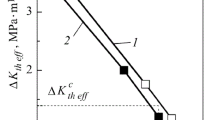Conclusions
-
1.
The anomalous behavior of hydrogen in technical iron at temperatures below 300°C is a result of a change in the character of diffusion of the grain-boundary component of the hydrogen flow in iron.
-
2.
Even a short-term exposure of technical iron at elevated temperatures to hydrogen at a low pressure leads to the formation of a network of through submicroscopic cracks and pores permeable by inert gases.
-
3.
Changes in the linear dimensions of cementite as a result of the magnetic transformation near 200°C lead to a large increase in the size of micropores at temperatures below 200°C.
-
4.
The character of the diffusion of hydrogen along grain boundaries in technical iron varies with temperature. At temperatures below 200°C the grain-boundary component of the diffusion constitutes largely a viscous laminar flow of molecular hydrogen through large-diameter pores. At temperatures above 200°C the grain-boundary flow of hydrogen in iron constitutes thermally activated molecular flow of a single layer of partially dissociated hydrogen migrating along the walls of small-diameter submicroscopic pores. With rising temperature and increasing degree of dissociation of hydrogen the dependence of the grain-boundary flow on the gas pressure on the specimen inlet side approaches more and more closely the square root law.
Similar content being viewed by others
Literature cited
O. Richardson, Phil. Mag., No. 7, 226 (1904).
I. Borelius and S. Lindbom, Ann. Phys.,82, No. 2 (1927).
C. J. Smithells and C. E. Ransley, Proc. Roy. Soc.,150, 172 (1935).
W. R. Ham and W. L. Rast, Trans. Amer. Soc. Metals,26, 885 (1938).
W. R. Heller, Stress-Corrosion Crack Embrittlement, Wiley, New York (1956), p. 163.
J. Hewitt, Hydrogen in Steel, Special Report No. 73, Iron and Steel Institute, London (1962), pp. 83–89.
M. L. Hill and E. W. Johnson, Trans. AIME,215, 717 (1959).
E. W. Johnson and M. L. Hill, J. Met.,11, No. 9 (1959).
W. R. Ham, Trans. Amer. Soc. Metals,25, 536 (1936).
V. M. Sidorenko et al., Fiz.-Khim. Mekh. Mater., No. 3 (1968); No. 2 (1969).
V. M. Sidorenko and I. I. Sidorak, Fiz.-Khim. Mekh. Mater., Nos. 1 and 4 (1973).
R. Berrer, Diffusion in Solids [Russian translation], IL (1948).
W. L. Bryan and B. F. Dodge, AICRE J.,9, 223 (1963).
D. V. Alekseev and V. V. Ostroumov, MPKh,4, No. 4 (1933).
W. Baukloh and W. Kronengels, Arch. Eisenhüttenw.,11, No. 3 (1937).
M. B. Whiteman and A. R. Troiano, Corrosion,34, No. 1 (1965).
N. N. Kalgatin et al., Metalloved. Term. Obrab. Met., No. 7 (1959).
L. A. Glikman et al., Zh. Tekh. Fiz.,22, No. 7 (1952).
P. S. Wologdine, Compt. Rend.,148, 776 (1909).
Honda and Tokahi, Sci. Rep. Tohoku Univ.,6, 150 (1917).
V. L. Košelev, Neue Hutte,2, No. 10 (1957).
Author information
Authors and Affiliations
Additional information
Translated from Fiziko-Khimicheskaya Mekhanika Materialov, Vol. 11, No. 6, pp. 28–34, November–December, 1975.
Rights and permissions
About this article
Cite this article
Sidorenko, V.M., Sidorak, I.I. & Parkheta, R.G. Causes of the anomalous variation in the parameters of diffusion of hydrogen in iron at temperatures near 200°C. Mater Sci 11, 642–647 (1976). https://doi.org/10.1007/BF00716493
Received:
Issue Date:
DOI: https://doi.org/10.1007/BF00716493




